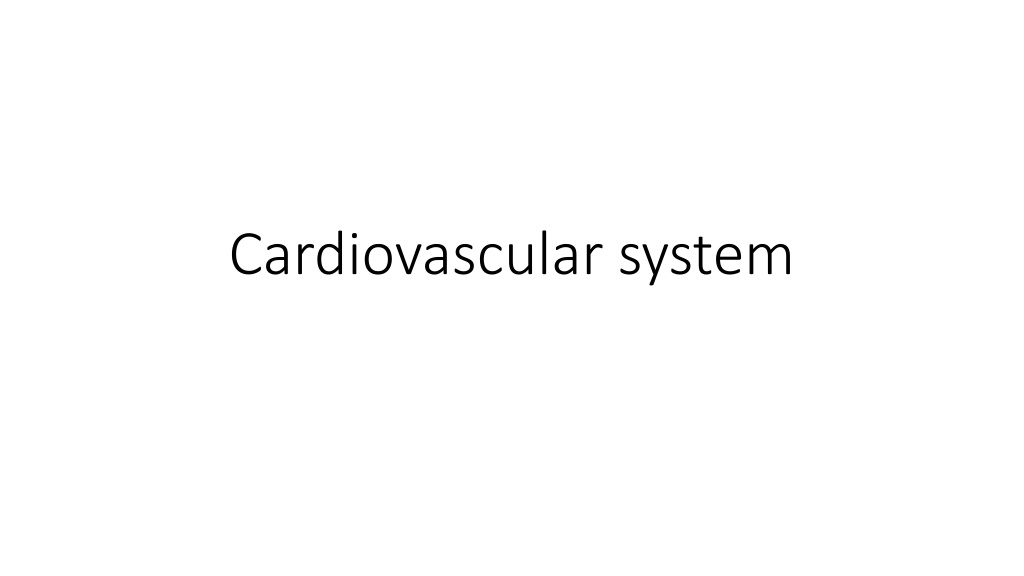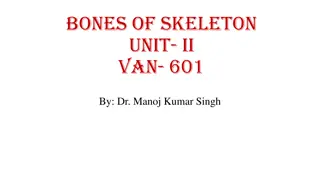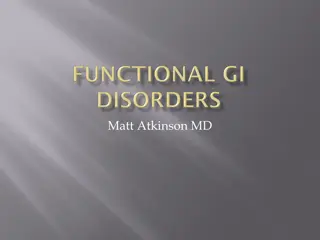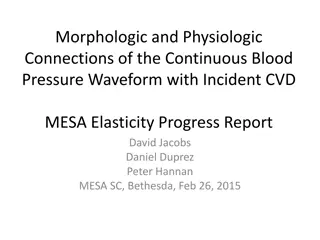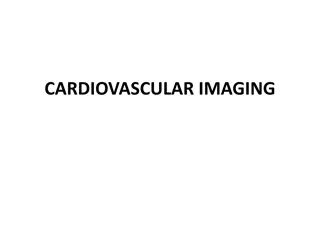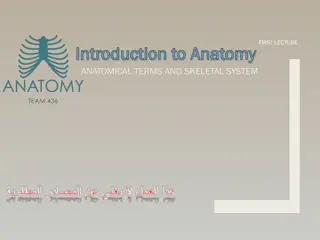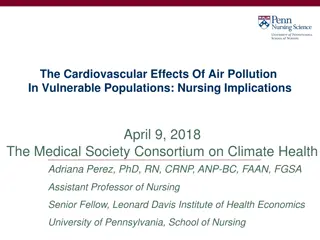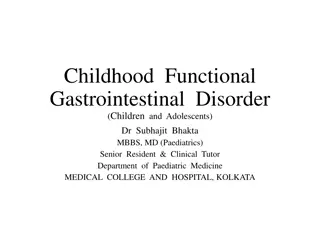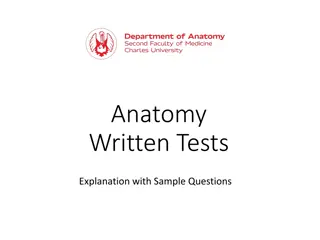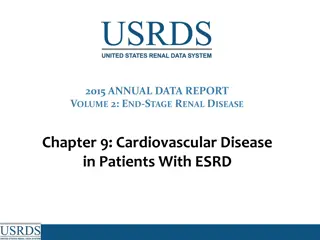The Cardiovascular System: Anatomy and Disorders
The cardiovascular system encompasses the heart, blood, and blood vessels. Understanding the anatomy of the heart's chambers, septa, and valves is crucial for grasping its functions. Additionally, exploring common word elements related to heart health can provide insights into medical terminology. Cardiologists specialize in diagnosing and treating heart disorders, including arrhythmias, which result from electrical malfunctions. Discover the intricate workings of this vital system and learn about procedures used to address heart conditions.
Download Presentation

Please find below an Image/Link to download the presentation.
The content on the website is provided AS IS for your information and personal use only. It may not be sold, licensed, or shared on other websites without obtaining consent from the author.If you encounter any issues during the download, it is possible that the publisher has removed the file from their server.
You are allowed to download the files provided on this website for personal or commercial use, subject to the condition that they are used lawfully. All files are the property of their respective owners.
The content on the website is provided AS IS for your information and personal use only. It may not be sold, licensed, or shared on other websites without obtaining consent from the author.
E N D
Presentation Transcript
The cardiovascular system comprises the heart, the blood, and the blood The cardiovascular system comprises the heart, the blood, and the blood vessels(which includes all the arteries, veins, and capillaries, that carry blood to all vessels(which includes all the arteries, veins, and capillaries, that carry blood to all parts of the body parts of the body The Heart The membrane forming the outer lining of the heart is called the epicardium. Immediately beneath the epicardium is the myocardium, comprising the muscles, blood vessels, and nerve tissue that make up the bulk of the heart. The heart's inner surface is called the endocardium. The heart is surrounded by a sac called the pericardium (peri- means around) Layers of the heart and pericardium
The heart has four chambers: the right atrium, the right ventricle, the left atrium, and the left ventricle. They are separated by septa(singular, septum). The names and locations of the septa are easy to remember because they include the names of the parts they separate. They are the interventricular septum (separates the two ventricles) and the interatrial septum (separates the two atria). Also, each atrium is divided from each ventricle by an atrioventricular septum, which contains various valves. The right atrioventricular valve, also sometimes called the tricuspid valve, leads from the right atrium into the right ventricle. The pulmonary semilunar valve connects the right ventricle to the lungs, which also connect to the left ventricle through the left atrium by way of the left atrioventricular valve, also sometimes called the bicuspid or mitral valve. The aortic semilunar valve leads out of the left ventricle. The structures of the heart
COMMON WORD ELEMENTS RELATED TO THE HEART COMMON WORD ELEMENTS RELATED TO THE HEART Word or Word Element Refers to aort/o aorta atri/o atrium brady- slow card/i/o heart corona the adjective form coronary is sometimes used to describe anatomic structures, such as nerves, ligaments, and blood vessels, especially the arteries of the heart electr/o electrical endo- inside peri- around, surrounding -stenosis a narrowing
Heart Disorders and Procedures Heart Disorders and Procedures Disorders of the heart are diagnosed and treated by cardiologists, who work in the field of cardiology. The heart can be compared to a mechanical device that relies on electricity for its operation. Electrical impulses emitted within the heart stimulate the heart to pump. When the electrical system malfunctions, the heart will beat too fast, too slow, at an irregular pace, or not at all, depending on the nature of the malfunction. Arrhythmia is most often defined as an irregular heartbeat at any speed. When the heart pumps too fast, defined as any rate greater than 100 beats per minute, the condition is called tachycardia. The Greek word for fast, tachys, gives us the prefix tachy- and also the common English word tachometer. A heart that is pumping too slow, which is defined as any rate less than 60 beats per minute, exhibits a condition known as bradycardia. The prefix brady- is also of Greek origin, coming from the word for slow : bradys. Tachycardia is also called tachyarrhythmia, and bradycardia is called bradyarrhythmia. Ischemia(meaning " to keep back" )is defined as a deficiency of blood flow and oxygen to the myocardium.
COMMON DISORDERS AND PROCEDURES ASSOCIATED WITH THE HEART COMMON DISORDERS AND PROCEDURES ASSOCIATED WITH THE HEART Term Definition atriomegaly enlargement of an atrium Bradycardia also called bradyarrhythmia; abnormally slow heartbeat cardiodynia heart pain cardiogram (This word and the next are often called electrocardiogram and electrocardiograph, respectively; the abbreviation for both can be either EKG or ECG.) a graphic trace of heart functions cardiograph (also myocardiograph, as well as electrocardiograph, as noted above) a machine to electrically measure heart functions Echocardiography (from the Greek ekhe meanssound; cardi/o means heart; -graphy is the process of recording) Ultrasonic procedure used to evaluate the structure and motion of the heart Sphygmomanometer Instrument used to measure blood pressure cardiomegaly enlargement of the heart cardiomyopathy disease of the heart muscle (myocardium) cardiopathy any heart disease cardiorrhexis rupture in the wall of the heart muscle carditis inflammation of the heart endocarditis inflammation of the endocardium myocardial infarction (often abbreviated MI) heart attack; patients suspected of having had an MI are given a blood test to measure the level of troponin in the blood (troponin is a protein that is released when an MI occurs)
Read the following excerpt from a cardiac catheterization report and answer the questions: Left ventriculography shows the left ventricle is normal in configuration, dimensions, and segmental wall motion with ejection fraction computed at 58% by area-length method. There is no evidence of mitral regurgitation. Coronary arteriography of left anterior descending artery shows 70% focal stenosis immediately after the first septal perforator branch. What word root and suffix are contained in the term ventriculography? What does the term mean? What does the adjective coronary mean? What does the word stenosis mean? View Answer 1. ventricul/o (root) -graphy (suffix); a record of the ventricle 2. heart-related 3. obstruction
Common Abbreviations Common Abbreviations
Pharmacology Pharmacology Cardiac glycosides: are drugs that increase the force of the myocardial contractions without causing an increase in oxygen consumption. Antiarrhythmics: (anti- means against, a- means without, rhythm means regular recurrence, -ic is an adjective suffix meaning pertaining to), drugs used to restore heart rhythm to normal. Diuretics: drugs used to remove water or fluid from the body, thus decreasing blood pressure and workload of the heart. Vasodilators: (vas/o means vessel; dilate means open up a hollow structure) these drugs are used to increase the lumen of the blood vessels, and prescribe for treating the high blood pressure conditions (hypertension HTN). Vasoconstrictors: (vas/o means vessel; constriction means narrow the opening of the hollow structure) decrease the inside diameter of the blood vessels, causing an increase in blood pressure. Vasoconstrictors are are used for treating low blood pressure conditions (hypotension).
Pharmacology (R.S.) Sneezing, coughing, nasal congestion, fever, wheezing, and dyspnea (difficult breathing) are all symptoms of respiratory disorders that can be treated with pharmacologic agents. Following are some of the drug classifications used in treating respiratory conditions: Antipyretics: against fever Bronchodilators: open up (dilate) the bronchus Mucolytics: mucus dissolving Corticosteroids: treat inflammatory and allergic conditions Decongestants: reduce nasal congestion
